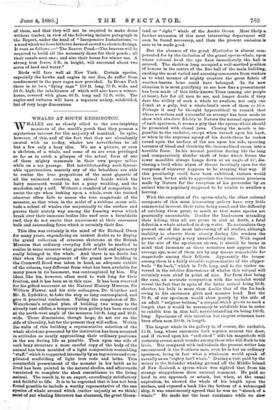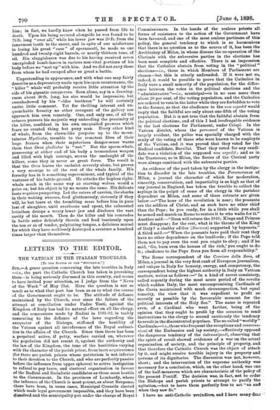WHALES AT SOUTH KENSINGTON.
WHALES are so closely allied to the awe-inspiring monsters of the world's youth that they possess a mysterious interest for the majority of mankind. In spite, however, of this, and of the fact that they are abundantly co-eval with us to-day, whales are nevertheless to all but a few only a hazy idea. We see a picture, or even a skeleton, of a whale, and some of us are even privileged so far as to catch a glimpse of the actual form of one of these mighty mammals in their own proper milieu while on a sea passage. But notwithstanding such favour- able opportunities, scarcely any of the beholders are able to realise the true proportions of the most gigantic of all the animated creation, an animal beside which the hairy mammoth would be but a puny weakling, and the mastodon only a calf. Without a standard of comparison to assist the eye when looking upon a whale, even the trained observer often fails to assess the true magnitude of the monster, so that when in the midst of a sublime ocean soli- tude a school of whales rise majestically to the surface and pursue their stately way among the foaming waves which break over their immense bodies like surf over a formidable reef, they do not excite that amazement at their enormous bulk and astounding force which is certainly their due.
This idea was certainly in the mind of Sir Richard Owen for many years, engendering an earnest desire so to display Lire grand collection of cetacean skeletons at the British Museum that ordinary everyday folk might be enabled to realise in some measure what grandeur of bulk and symmetry really belonged to the whale. And there is no doubt but that when the arrangement of the grand new building in the Cromwell Road was taken in hand, an adequate exhibit of the cetacea, very different from what has been available for many years in its basement, was contemplated by him. Big ideas like his, however, often need to wait long for their fruition, and it has been so in this case. It has been reserved for his gifted successor at the Natural History Museum, Sir William Flower, and his able colleagues, Dr. Gunther and Mr. R. Lydekker, to take the step so long contemplated, and give it practical realisation. Failing the completion of Mr. Waterhouse's original plan, of building two wings to the already vast edifice, a temporary iron gallery has been erected at the north-west angle of the museum 140 ft. long and 40 ft. wide. These dimensions, though large, do not err on the aide of liberality, but for the present they will suffice. Within he walls of this building a representative selection of the whale skeletons possessed by the institution has been mounted in attitudes as nearly approaching their ordinary positions in the sea daring life as possible. Then upon one side of each bony structure a most careful copy of the body of the animal has been moulded of a light composition resembling "staff," which is supported internally by an ingenious and COM- plicated scaffolding of light iron rods and laths. This counterfeit presentment of the monster in his habit as he lived has been painted in the natural shades, and afterwards Tarnished to complete the sleek resemblance to the living animal. The result is, to an expert, exceedingly satisfactory -and faithful to life. It is to be regretted that it has not been found possible to include a worthy representative of the one (species of whale around which (rather unjustly as we think) most of our whaling literature has clustered, the great Green- land or " right " whale of the Arctic Ocean. Most likely a further extension of this most interesting department will soon be found necessary, and then the present omission is sure to be made good.
But the absence of the great Ifystieetus is almost com- pensated for by the inclusion of the grand sperm-whale, upon whose colossal bead the eye fixes immediately the hall is entered. The skeleton long occupied a well-merited position of honour in the centre of the fine hall of the main building,. exciting the most varied and amusing comments from visitors as to what manner of mighty creature the great fabric of weather-beaten bone could have belonged. In its new situation it is most gratifying to see how fine a presentment has been made of this little-known Titan (among our people at least), fair for all men to see, and longer doubt if they dare the ability of such a whale to swallow, not only one Jonah at a gulp, but a whale-boat's crew of them en bloc. Perhaps it may be thought hypercritical to remark that where so serious and successful an attempt has been made to show with absolute fidelity to Nature the normal appearance of each specimen, it seems a pity that the sperm-whale should be presented with closed jaws. Closing the mouth is im- possible to the cachalot, except when turned upon his back, or when in the supreme agony of his death-throe he rushes round upon the surface of the sea upon his side, spouting torrents of blood and churning the incarnadined ocean into a horrible foam. In his normal position during life the long and comparatively slender shaft of bone which forms the lower mandible always hangs down at an angle of 450, dis- closing a livid white abyss of throat invitingly open for the reception of whatever happens to be straying that way. If this peculiarity could have been exhibited, visitors would have been better able to appreciate the bounteous provision made by Nature for the reception of his provender by an animal who is popularly supposed to be unable to swallow a herring.
With the exception of the sperm-whale, the other colossal occupants of this most interesting gallery have very little commercial interest, their value being small and the difficulty of catching them great, so much so that some species are practically uncatcha-ble. Besides the hindrances attending their killing, they all are prone to sink at death, a fatal defect in a whale attacked in deep water. To naturalists they present one of the most interesting of all studies, although inability to observe them closely during life renders the pursuit of cetology a very unsatisfactory one. With regard to the size of the specimens shown, it should be borne in mind that immense as these monsters now appear to the average eye, none of them are by any means remarkable for magnitude among their fellows. Apparently the largest among them is a fairly sizeable representative of the clipper- built "fin-back," which is 70 ft. long, and to the visitor un- versed in the relative dimensions of whales this rorqual will certainly seem chief in point of size. Far from that being the case, an accurate comparison with the cachalot would reveal the fact that in spite of the latter animal being 16 ft. shorter, his bulk is more than double that of the fin-back owing to his enormous girth and massive head. But the 70 ft. of our specimen would show poorly by the side of an adult 'sulphur-bottom," a rorqual which grows to such a length that it would be necessary to subdivide him in order to exhibit him in this hall, notwithstanding its being 140 ft. long. Specimens of this valueless but elegant edam= have been often seen 200 ft. in length.
The largest whale in the gallery is, of course, the cachalot, 54 ft. long, whose enormous bulk reposes nearest the door, and if viewed upon his "enfleshed " side his magnitude will certainly arouse much wonder among those who will flock to his levee. But compared with individuals the present writer has encountered in the Southern seas, even he is but an ordinary specimen, being in fact what a whaleman would speak of casually as an "eighty bar'l whale." During a visit paid by the writer to the Solander whaling ground off the Middle Island of New Zealand, a sperm-whale was sighted that from his strange sluggishness drew unusual comment. He paid no heed to our approach or attack, but when, at the usual expiration, he showed the whole of his length upon the surface, and exposed a back like the bottom of a submerged ship, it was unanimously agreed that he was no "slouch of a whale." He made not the least resistance while we slew
him ; in fact, we hardly knew when he passed from life to death. Upon his being secured alongside he was found to be 78 ft. long "over all," while his lower jaw was 20 ft. from the innermost tooth to the snout, and in spite of our misfortune in losing his great " case " of spermaceti, he made us one hundred and twenty-eight barrels, or nearly thirteen tuns, of oil. His sluggishness was due to his having received seven unexploded bomb-lances in various non-vital portions of his body before we "met up" with him. And we did not envy those from whom he had escaped after so great a battle.
Unpretending in appearance, and with what one may fairly describe as a deprecatory smile upon his open countenance, the " killer " whale will probably receive little attention by the side of his gigantic conquerors. Seen alone, say in a drawing- room about 30 ft. long, his size would be impressive, but overshadowed by his "elder brethren" he will certainly excite little comment. Yet for thrilling interest and un- quenchable ferocity no other occupant of the gallery can approach him even remotely. One, and only one, of all the cetacea pursues his majestic way unheeding the proximity of the killer, confident in his own unequalled prowess which fears no created thing but puny man. Every other kind of whale, from the clown-like porpoise up to the moun- tainous Mysticetw, tremble to the remotest fibre of their huge frames when their mysterious danger-sense warns them that Orca gladiator is "out." But the sperm-whale, possessing at either end of his body a tremendous weapon and filled with high courage, scorns the onslaught of the killers, come they in never so great force. The result is that the Orca leaves the cachalot severely alone, but proves a very scourge to all the rest of the whale family. His ferocity has in it something supereminent, and typical of the 'vastness of his battle-ground. He attacks the hapless right'. whale much in the same way as starving wolves would a prize ox, but his object is by no means the same. His delicate taste requires pampering. Let the eaters of carrion, the sharks in their waiting swarms, feed gluttonously, riotously if they will, he but tears at the trembling mass before him in pure lust of slaughter, until overborne and spent, the exhausted leviathan droops a weary lower jaw and discloses the vast cavity of his mouth. Then do the killer and his comrades in battle enter delicately therein and feed lusciously upon the ton or so of tender, palpitating tongue, a delicious morsel for which they have recklessly destroyed a creature a hundred times larger than themselves.



































 Previous page
Previous page